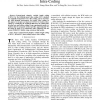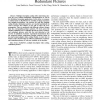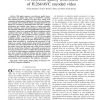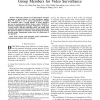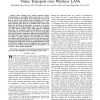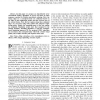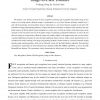TCSV
2010
13 years 6 months ago
2010
Context-based adaptive variable length coding (CAVLC) for the H.264/advanced video coding (AVC) standard was originally designed for lossy video coding, and as such does not yield ...
TCSV
2010
13 years 6 months ago
2010
Abstract--Multiple description coding offers interesting solutions for error resilient multimedia communications as well as for distributed streaming applications. In this letter, ...
TCSV
2010
13 years 6 months ago
2010
This paper addresses the rate allocation problem for wireless video streaming. Results from a simple subjective viewing test indicate that perceptually preferred allocation can be...
TCSV
2010
13 years 6 months ago
2010
Abstract--This paper proposes a no-reference quality assessment metric for digital video subject to H.264/AVC encoding. The proposed metric comprises two main steps: coding error e...
TCSV
2010
13 years 6 months ago
2010
This paper presents a novel approach for automatic recognition of group activities for video surveillance applications. We propose to use a group representative to handle the recog...
TCSV
2010
13 years 6 months ago
2010
Background subtraction (BS) is an efficient technique for detecting moving objects in video sequences. A simple BS process involves building a model of the background and extractin...
TCSV
2010
13 years 6 months ago
2010
Video transport over wireless networks requires retransmissions to successfully deliver video data to a receiver in case of packet loss, leading to increased delay time for the dat...
TCSV
2010
13 years 6 months ago
2010
We present an efficient and accurate method for duplicate video detection in a large database using video fingerprints. We have empirically chosen the Color Layout Descriptor, a c...
TCSV
2010
13 years 6 months ago
2010
In this paper we propose an edge-directed error concealment (EDEC) algorithm, to recover lost slices in video sequences encoded by flexible macroblock ordering. First, the strong e...
TCSV
2010
13 years 6 months ago
2010
We propose a new distance measure for face recognition and human gait recognition. Each probe image (a face image or an average human silhouette image) is represented as a set of ...
